Gentle, prolonged ocular massage can restore vision after retinal artery occlusion
The procedure is performed under direct visualization for an extended period of time.
Click Here to Manage Email Alerts
Sudden onset of visual loss from retinal artery occlusion has a poor prognosis. Ophthalmologists routinely aggressively massage an eye with acute retinal artery occlusion for only a few minutes at best. However, an updated technique using gentle massage and rapid changes of IOP over a longer period of time can restore vision.
This is a description of a technique for gentle ocular massage of the eye for retinal artery occlusion under direct visualization of the retinal artery. Two case reports of patients with retinal artery occlusion and severe visual loss who had their vision restored by this method are also presented.
Description of method
This technique involves small rapid changes of IOP over a period of 1 to 3 hours, until all retinal emboli have been cleared from the vessel.
While directly visualizing the optic nerve and retinal arteries through a 78-D lens, a third finger is used to gently apply pressure to the sclera of the anesthetized eye. The eye is indented with one finger for only a few millimeters, pressing in and then releasing repetitively at a frequency of two to three times a second (Figure 5).
During the procedure the emboli are observed as they dislodge and then move distally through the branches of the retinal arteries. The procedure is continued until all emboli have passed through and the patient reports improved vision.
Case No. 1
A 48-year-old white female patient presented with the complaint of sudden loss of vision OD twice earlier in the day. On arrival to the eye clinic, her vision was initially 20/30 OD. Shortly thereafter she complained of complete blackness in the right eye. Repeat measurement of her vision showed that she could only count fingers in a small area in the superior temporal visual field of the right eye. Dilated funduscopic exam demonstrated a central retinal artery occlusion with all branches of the retinal artery containing only a small amount of blood.
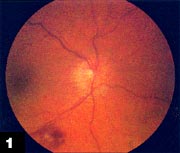
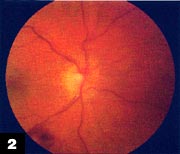
Direct visualization of retinal artery emboli before and after continous massage.
Images: Littleton Baker D
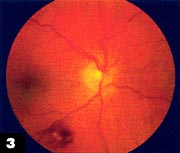
Multiple emboli pass distally through the inferior temporal branch artery after being dislodged by massage.

The last group of emboli is dislodged, reestablishing blood flow.
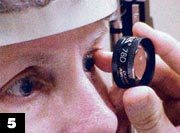
The massage technique uses a third finger, which applies gentle pressure to the sclera.
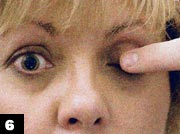
Once the technique begins moving the emboli, continuous gentle massage is applied with one finger to the anterior chamber through a closed eyelid.
Ocular massage was initiated by the above method. Direct visualization showed multiple emboli, which completely cleared in the superior temporal and superior nasal branches of the central retinal artery after 1 hour of massage. Emboli could be directly visualized passing through the vessels. The patient noted that the light became much brighter as the blood flow was reestablished.
Ocular massage was carried out to clear the lower two branches of the central retinal artery. Multiple emboli were seen to move through the vessels as demonstrated in Figure 1 (before massage) and Figure 2 (after continued massage). After multiple emboli were dislodged, a large shower of retinal emboli filled the inferior temporal branch artery (Figure 3). Massage was continued until this last group of emboli was dislodged and blood flow was reestablished (Figure 4). After this technique the patient noticed 20/30 vision with a superior arcuate defect. The following day she had 20/20 vision.
Case No. 2
A 58-year-old white female patient with carotid disease presented with intermittent “black” vision for several hours. She was examined in the office with 20/60 vision initially, which then became totally “black.” Her eye was dilated and observed to have no flow of blood through the superior temporal retinal artery. Ocular massage, as described previously, was done under direct visualization of the retinal artery. Multiple emboli could be seen passing through the retinal artery and blood flow was reestablished. Many more emboli alternately obstructed the artery and then passed through with massage. Massage was carried out for approximately 1 hour until no further emboli were seen. The patient noted return of vision. Final vision 5 weeks later was 20/25.
Discussion
Retinal artery occlusions carry such a poor prognosis that ophthalmologists often go through the routine for treatment all the while knowing that the chance of improved vision is unlikely. I believe that this is due to an error in technique in massage of the eye and giving up too quickly.
Small gentle indentions of the globe, instead of vigorous massage, appear to offer hope in these patients. Apparently, the prolonged, rapid small changes in IOP are more conducive to dislodging emboli than a brief high-pressure aggressive massage of the eye. It is even more encouraging to the ophthalmologist to actually see the emboli passing through the vasculature and the reestablishment of ocular blood flow while looking through the 78-D lens.
The emboli tended to be more than one or two in number in both patients; multiple emboli were present. If an ophthalmologist stopped massaging the eye after only a few minutes, even if one or two emboli were dislodged, more emboli would rapidly follow and reocclude the vessel. Therefore, it is important to visualize the retinal artery and continue the massage until all the emboli have passed through. This takes time and patience, even as long as 3 hours in one patient.
It is interesting that when the emboli were noted to pass through the vessel in patient No. 1, the patient volunteered the information that the light was growing brighter. This can also give one feedback as to the effectiveness of the procedure.
Once you are convinced that the massage is working, a trained technician can apply the short gentle massage with one finger to the anterior chamber through a closed eyelid while having the patient look straight ahead (Figure 6). The ophthalmologist can then intermittently check the patient to see if there are still persistent emboli.
I believe that this new technique of lighter pressure ocular massage under direct visualization, combined with persistent determination on the part of the ophthalmologist, could result in restored sight for many retinal artery occlusion patients who previously had little hope.
For Your Information:
- David Littleton Baker, MD, FACS, can be reached at the Arkansas Eye Center, P.O. Box 1490, Conway, AR 72034; e-mail: dbakermd@yahoo.com.
